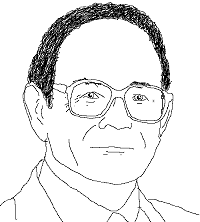 Gerald Edelman has died, at the age of 84. He won his Nobel prize for work on the immune system, but we’ll remember him as the author of the Theory of Neuronal Group Selection (TNGS) or ‘Neural Darwinism’.
Gerald Edelman has died, at the age of 84. He won his Nobel prize for work on the immune system, but we’ll remember him as the author of the Theory of Neuronal Group Selection (TNGS) or ‘Neural Darwinism’.
Edelman was prominent among those who emphasise the limits of computation: he denied that the brain was a computer and did not believe computers could ever become conscious…
In considering the brain as a Turing machine, we must confront the unsettling observations that, for a brain, the proposed table of states and state transitions is unknown, the symbols on the input tape are ambiguous and have no preassigned meanings, and the transition rules, whatever they may be, are not consistently applied. Moreover inputs and outputs are not specified by a teacher or a programmer in real-world animals. It would appear that little or noting of value can be gained from the application of this failed analogy between the computer and the brain.
He was not averse to machines in general, however, and was happy to use robots for parts of his own research. He drew a distinction between perception, first-order consciousness, and higher-order consciousness; the first could be attained by machines we could build now; the second might very well be possible for machines of the right kind eventually – but there was much to be done before we could think of trying it. Even higher-order consciousness might be attainable by an artefactual machine in principle, but the prospect was so remote it was pointless to spend any time thinking about it.
There may seem to be a slight tension here: Turing machines are ruled out, but machines of another kind are ruled in. Yet the whole point of a Universal Turing Machine is that it can do anything that any machine can do?
For Edelman the point was that the brain required biological thinking, not just concepts from physics or engineering. In particular he advocated selective mechanisms like those in Darwinian evolution. Instead of running an algorithm, the brain offered up a vast range of neuronal arrays, some of which were reinforced and so survived to exert more influence subsequently. The analogy with Darwinian evolution is not precise, and Francis Crick famously said the whole thing could better be called ‘Neural Edelmanism’ (no-one so bitchy as a couple of Nobel prize-winners).
Edelman was in fact drawing on a different analogy, one with the immune system he understood so well. The human immune system has to react quickly to invading infections, synthesising antibodies to new molecules it has never encountered before; in fact it reacts just as effectively to artificial molecules synthesised in the lab, ones that never existed in nature. For a long time it was believed that the system somehow took an impression of the invaders’ chemistry and reproduced it; in fact what it does is develop a vast repertoire of variant molecules; when one of them happens to lock into an invader it then reproduces vigorously and produces more of itself to lock into other similar molecules.
This looks like a useful concept and I think Edelman was right to think it has a role to play in the brain: but working out quite how is another matter. Edelman himself built a novel idea of recategorisation based on the action of re-entrant loops; this part of the theory has not fared very well over the years. The NYT obituary quotes Gunther Stent who once said that as professor of molecular biology and chairman of the neurobiology section of the National Academy of Sciences, he should have understood Edelman’s theory – but didn’t.
At any rate, we can see that Edelman believed that when a conscious machine was built in the distant future it would be running a selective system of some kind; one that we could well call a machine in everyday terms, though not in the Turing sense. He just might be vindicated one day.
